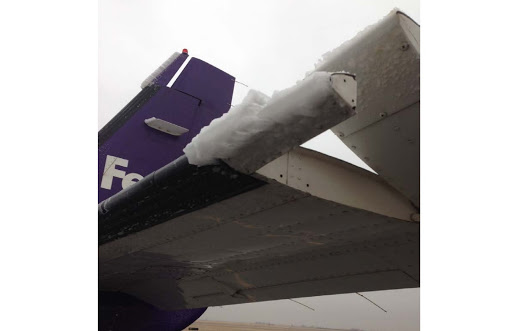Operating Tips for an Icing Encounter in the Cessna Caravan
In the Northern Hemisphere Winter is right around the corner, and with it comes increased chances that the Caravan that you fly will have an icing encounter. Are you familiar with the various steps that you can take to help manage the impact of an icing encounter? Whether you own, fly or manage a Cessna Caravan, we here at Caravan Nation recommend that you, not only read this article, but print and save the below listed operating tips for future reference.
The operating tips listed below are part of the FedEx Caravan Icing Program. A program that you should acknowledge and possibly incorporate it into your own program.
In the Caravan, like every other airplane, you can help manage the impact of an icing encounter by remembering two general rules:
A) Keep the airspeed/power up and,
B) Keep the deck angle/AOA down.
Additionally we recommend that you consider the following:
1. Make sure that you receive a thorough weather briefing. Know the right questions to ask, and don't hesitate to ask them.
2. Compare frontal movement with the proposed flight path, remember to look well up-wind of your course line to see what kind of weather is approaching your flight path.
3. Pre-flight ALL of the aircraft anti/de-ice systems for proper operation and cycle sequences.
4. Periodically wax areas of the aircraft that are exposed to ice accumulation: e.g.
- Nose wheel fairings & accessories (not the shock)
- Engine cowling
- Cargo pod
- Wing-strut/wing-joint area including tie-down hook
- Main landing gear dressing including brake-pad housing, but not the brake-disk
- Gurney-strip of the trailing edge of the flaps
- Left & right outer elevator horn
6. Use of flaps for take-off should be carefully evaluated when icing is anticipated during departure.
7. Remember... snow, slush, or water standing on the runway will greatly increase the required take-off distance, as well as landing roll. Be particularly careful when a take-off is being conducted. Slow acceleration to liftoff speed followed by an ABORT will require considerably more runway. Therefore, where a choice can be made, pick the longest runway for both take-off and landing.
8. After take-off, increase speed to 110-115 kts as quickly as possible. This will help keep ice formation on the protected areas of the aircraft. Continue to climb with a minimum deck-angle.
9. At airports where SIDs are used, pick a direction of departure which has the lowest climb-gradient. Once you are at a safe altitude you can then proceed to your destination.
10. Constantly monitor & assess the icing situation of your aircraft. Be particularly alert to OAT changes during the climb. Observing the OAT during your climb to altitude can provide clues which could save your life.
11. Consider not using the auto-pilot when operating in ice. This is not to imply that the auto-pilot is not approved for ice operation, but that a pilot can not possibly know how the aircraft is FEELING if the auto-pilot is engaged.
12. When encountering icing and the airspeed begins to drop below 130 KIAS, MAXIMUM CONTINUOUS POWER e.g. 1865# torque/805 C ITT (675 HP) as applicable, should be used.
13. De-ice boots are more effective at higher airspeeds. At lower speeds effectiveness may be improved by SMOOTHLY changing the pitch attitude as the boots are being MANUALLY inflated which will allow the changing relative wind to assist in removing the ice from the wing leading edge.
14. A vibration may occur as ice starts to build on the propeller hub and the back side of the blade near the hub. Under extreme conditions the vibration may continue to increase the the point where the instrument panel begins to shake. In conditions of MODERATE and above accumulation rates, the automatic propeller anti-ice system may not be sufficient to keep the propeller clear of ice. Under these conditions, consider using the MANUAL propeller anti-ice feature and briskly cycling the prop between the maximum and minimum RPM (minimum 200 RPM change) to assist in removing the ice.
15. Don't keep flying into deteriorating conditions. Have a plan, e.g. climb, descend or turn to get to less severe conditions if it become necessary. KEEP YOUR SITUATIONAL AWARENESS AHEAD OF THE AIRPLANE. DON'T ALLOW YOURSELF TO RUN OUT OF OPTIONS!
16. Communicate your situation with ATC. Keep them advised of your icing problems. Asking for help is not a sign of weakness. Failing to use all of the resources at your disposal is sellling yourself short. DON'T LET A MACHO ATTITUDE OVERLOAD YOUR BOAT!
17. Monitor the terminal approach frequency while you are still in the enroute portion. This will allow you to listen-in on any problems other pilots may be encountering while in their attempt to land. During the approach keep your air-speed at least 15-20 knots higher than normal. Stall speed increases with ice accumulation.
18. Do not cycle the boots during landing since boot inflation may increase stall speeds by as much as 10 knots.
19. Fly the aircraft down-to-the-ground, do not attempt a normal flare-out to a stalled landing.
If you have any questions about this article, use the contact form on CaravanNation.com
Always remember to... "Never stop learning. Review often and never get complacent so that you can continue to fly safely!"

No comments:
Post a Comment